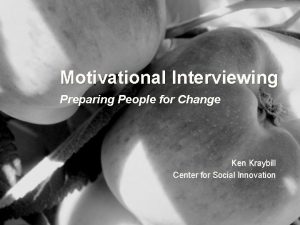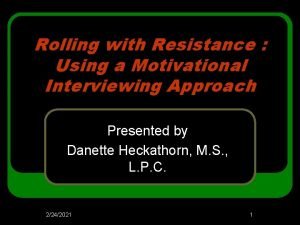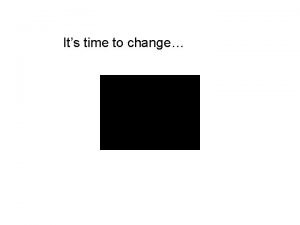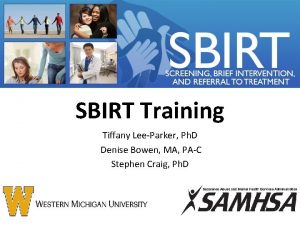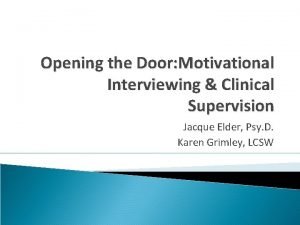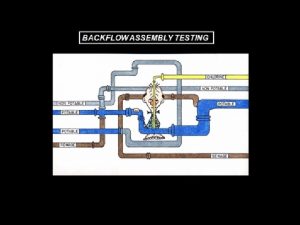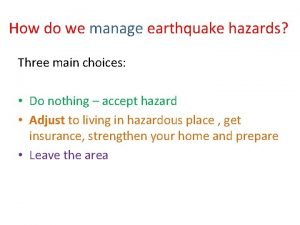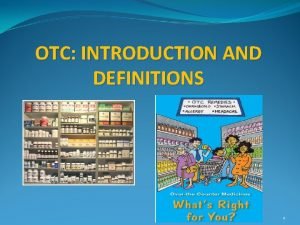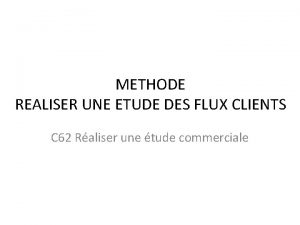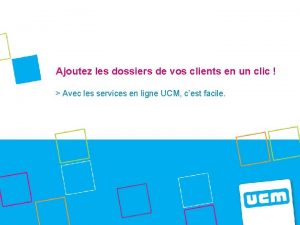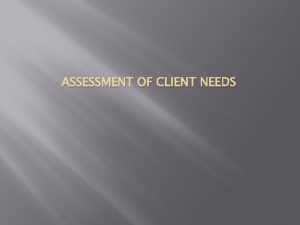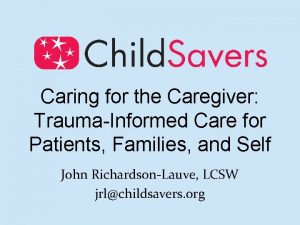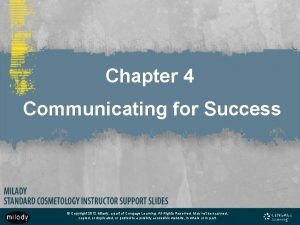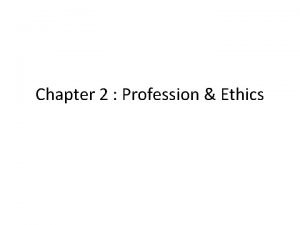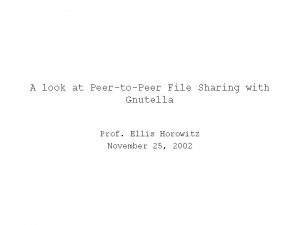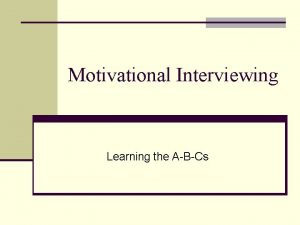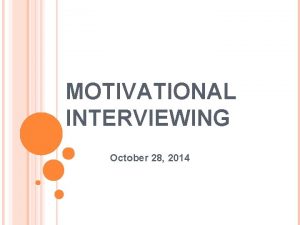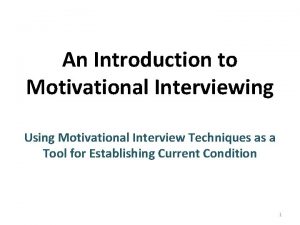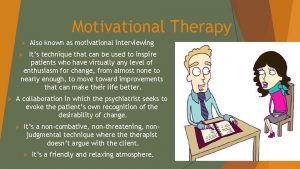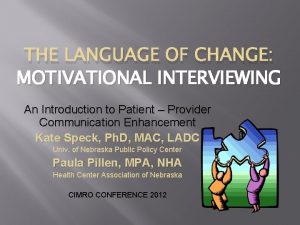Motivational Interviewing MI With Clients Resistant to Change

























































- Slides: 57

Motivational Interviewing (MI) With Clients Resistant to Change Mary T. Curtis, CAP

Agenda 1. 2. 3. 4. Explore Change…Motivation…Resistance Brief Overview of MI Therapist’s Role in MI Strategies…Roll With Resistance

How Does Behavior Change? Behavior A Behavior B 3

Introspective Exercise Think of a behavior you’ve tried to change How much time elapsed between: • The first time you engaged in the behavior, and • The first time you recognized risk or consequences? 4

Introspective Exercise How much time elapsed between: • The first time you recognized risk or negative consequences, and • The first time you made an earnest attempt to change the behavior? 5

Introspective Exercise • • • Did you ever experience some success in changing your behavior? What helped you achieve the success? Did you ever experience a resumption of or increase in the undesired behavior after experiencing some success? 6

Introspective Exercise • • • What did you discover about change? Did motivation play a role in your change? Where did you find your motivation? Is motivation enough? Did you experience any resistance? 7

Stages of Change Precontemplation Maintenance Action Contemplation Preparation James Prochaska, Ph. D. , and Carlo Di. Clemente, Ph. D.

Change • Change is fluid • Change is a process • Change is influenced by motivation 9

Motivation • • • Motivation is key to change Motivation is a dynamic & fluctuating state Motivation can be modified There are intrinsic and extrinsic motivators It can be influenced by relationships 10

Motivational Interviewing (MI) was developed in the late 1980’s by William Miller, Ph. D. and Stephen Rollnic, Ph. D. MI is now an established evidence-based practice in the treatment of individuals with substance use disorders.

Eight Stages in Learning MI 1. 2. 3. 4. 5. 6. 7. 8. The spirit of MI OARS – Client-centered counseling skills Recognizing and reinforcing change talk Eliciting and strengthening change talk Rolling with resistance Developing a change plan Consolidating client commitment Shifting flexibly between MI and other methods Miller, W. R. , & Moyers, T. B. (in press). Eight stages in learning motivational interviewing. Journal of Teaching in the Addictions.

“…a collaborative, person-centered form of guiding to elicit and strengthen motivation for change. ” (Miller & Rollnick, 2009)

Motivational Interviewing • The Why: Enhance Motivation for Change • The How: Identifying, exploring and resolving ambivalence about behavior change. 14

The Spirit of MI “…a collaborative, person-centered form of guiding to elicit and strengthen motivation for change. ” Autonomy. . . Collaboration…Evocation

The Spirit of MI • • Guiding, more than directing Dancing, rather than wrestling Listening, as much as telling Collaborative conversation Evokes from a person what he/she already has Motivation is elicited from the person Honoring of a person’s autonomy Source: S. Rollnick, W. Miller and C. Butler Motivational Interviewing in Health Care, 2008

Principles of MI There are five distinct principles: 1. 2. 3. 4. 5. Express Empathy Support Self-Efficacy Create Discrepancy Avoid Arguments Roll with Resistance 17

ACTIVITY. . . COLLABORATION 18

Therapeutic Alliance 19

There are necessary qualities a Therapist brings to a helping-relationship in order for it to be effective. 20

Necessary Qualities Skillset • Be Present • Effective Listener • Skilled Communicator • Emotionally Intelligent • Skilled in MI concepts, principles and strategies.

Necessary Qualities Mindset • • • Willing Accepting Committed Collaborative Empathetic Compassionate

Therapists and Client Motivation • • • Style/personality influence outcomes Empathic therapists have better outcomes Expectations influence outcomes Differences in drop-out rates Differences in outcome rates Simple actions decrease drop-out

The Professional’s Role • “Therapists adopting a hostileconfrontational style tend to elicit more withdrawal, lower involvement, distancing, and resistance. ” • “For those (women) with low self-image, confrontational group therapy appeared to have a detrimental effect. ” (Waltman, 1995, Journal of Substance Abuse Treatment)

MI Strategies 25

OARS-Opening Strategy • • Open-ended questions Affirmations Reflections Summaries 26

Change Talk • Client identifies that behavior might be problematic • Client expresses concern about a behavior • Client expresses a desire to change the behavior

Change Talk MI uses an acronym to identify types of “change-talk”. The acronym is DARN-C. 28

The Flow of Change Talk MI Desire Ability Reasons Need Commitment Change

Change Talk Preparatory Change Talk Desire (I want to change) Ability (I can change) Reason (It’s important to change) Need (I should change) 30

Change Talk Preparatory Change Talk Desire (I want to change) Ability (I can change) Reason (It’s important to change) Need (I should change) 31

Change Talk Implementing Change Talk • Commitment (I will make changes. ) • Activation (I am ready, prepared, willing) • Taking steps (I am taking actions to…) 32

Eliciting Change Talk • • Importance/Confidence Ruler Exploring problem Looking backward / Looking forward Exploring values and discrepancy with behavior Considering pros and cons (decisional balance) Exploring Extremes Planning and Committing 33

Resistance • In Motivational Interviewing “Resistance” is defined as a misalliance in the counselorclient relationship and not an inherent “symptom” of addiction. • Normal, natural and to be expected 34

Resistance • • Argue Deny a problem Accuse Interrupt Disagree Passively resist though minimal answers Overtly comply due to mandate Become angry 35

Resistance—Sustain Talk • MI currently uses the term “sustain-talk” to describe client communication that indicates a desire, plan or commitment to staying the same. 36

Resistance—Sustain Talk • “I don’t have a problem, it is all a mistake. ” • “You people are just out to make money on this. ” • “My wife thinks everyone has a problem because her father is an alcoholic. ” • “I know I need to cut down, but I can do it on my own. ” • “Coming to this program makes me feel worse, when do I get discharged? ” 37

Resistance—Responding • Roll with Resistance 38

Summary • A style…a way of interacting with clients. • The goal is to resolve the client’s ambivalence and guide them in the direction of making a positive change. • Goal oriented and solution focused. • Includes techniques to elicit “change talk” and “Sustain Talk. ” 39

Resistance—Responding • Reflective Techniques: – Simple Reflection – Double-sided Reflection – Amplified Reflection 40

Simple Reflection A simple reflection, mirrors or reflects back to the client the content, feeling or meaning of his/her communication. • Client: “I know I made a mistake but the hoops they are making me jump through here are getting ridiculous. ” • Therapist: “You are pretty upset about all this. It seems like everyone is overreacting to a mistake. ” 41

Double-Sided Reflection Attempts to reflect back both sides of the ambivalence the client experiences so that the client hears back both the “sustain-talk” in his/her communication and the “change-talk. ” An example is… 42

Double-Sided Reflection • Client: “I know that I made a mistake, but the hoops they are making me jump through are ridiculous. ” • Counselor: “You made a mistake and it sounds like you feel badly about that, but you also think that people are asking you to do too much. ” 43

Amplified Reflection Takes what the client said and increases the intensity of the “sustain-talk. ” When hearing an amplification of what was communicated, a client will often reconsider what he/she said and clarify. An example is… 44

Amplified Reflection • Client: “I know I made a mistake, but the hoops they are making me jump through are ridiculous. ” • Counselor: “You don’t agree with any of what they are making you do. ” • A client may respond to this, “No, I know I need to do some things to make this right but I am frustrated with this contract. ” 45

Strategic Techniques • • • Shifting Focus Coming Along Side Emphasizing Personal Choice and Control Reframe Agreement With a Twist 46

Shifting Focus Shifting focus attempts to get around a “stuck” point by simply side-stepping. An example, using the same client statement is: • Client: “I know I made a mistake, but the hoops they are making me jump through are getting ridiculous. ” • Counselor: “You are upset by all of these hoops. Can you tell me more about the mistake you think you make? 47

Coming Alongside This technique is used to align with the client. An example of coming along side is: • Client: “I know I made a mistake, but the hoops that they are making me jump through are getting ridiculous. ” • Counselor: “You may be at your limit and might not be able to keep up with all this. ” 48

Emphasize Personal Choice & Control • Clients ultimately always choose a course of action and this technique simply acknowledges this fact. Acknowledging this can sometimes help a client recognize that they are making a choice. An example is: 49

Emphasize Personal Choice and Control • Client: “I know I made a mistake, but the hoops that they are making me jump through are getting ridiculous. ” • Counselor: “You don’t like what others are asking you to do, but so far you are choosing to follow-through with what they are asking. It takes a lot of fortitude to do that. Tell me what motivates you. ” 50

Agreement With A Twist • This is a complex technique that combines a reflection with a reframe. This gives the client confirmation that they were “heard” and then offers another perspective on their communication. It is similar to a reframe and an example is: 51

Agreement With A Twist • Client: “I know that I made a mistake, but the hoops that they are making me jump through are getting ridiculous. ” • Counselor: “You are feeling frustrated with all these expectations. You are also anxious to be successful? ” 52

Summary • A style…a way of interacting with clients. • The goal is to resolve the client’s ambivalence and guide them in the direction of making a positive change. • Goal oriented and solution focused. • Includes techniques to elicit “change talk” and “Sustain Talk. ” 53

Strategies – Elicit Change Talk • • • OARS Exploring the Problem Looking Backward Looking Forward Considering Importance/Confidence Ruler Exploring Values Considering Pros and Cons Planning and Committing 54

Strategies – Decreasing Sustain-Talk • • Simple Reflection Double-sided Reflection Amplified Reflection Shifting Focus Coming Along-Side Emphasize Personal Choice and Control Reframe Agreement with a twist 55

Sources • • Center for Substance Abuse Treatment (1999). Enhancing Motivation for Change in Substance Abuse Treatment Improvement Protocol (TIP) 35. Rockville, MD: Substance Abuse and Mental Health Services Administration, Center for Substance Abuse Treatment. Miller, W. R. , Rollnick, S. (2002). Motivational Interviewing: Preparing People for Change. 2 nd Edition. New York: Guilford Press. Miller, W. R. & Rollnick, S. (2010). What's new since MI-2? Presentation at the International Conference on Motivational Interviewing (ICMI). Stockholm, June 6, 2010. Accessed at http: //www. fhi. se/Documents/ICMI/Dokumentation/June-6/Miller-and. Rollnick-june 6 -pre- conference-workshop. pdf Miller, W. R. , Zweben, A. , Di. Clemente, C. C. , & Rychtarik, R. G. (1992). Motivational Enhancement Therapy manual: A clinical research guide for therapists treating individuals with alcohol abuse and dependence. Rockville, MD: National Institute on Alcohol Abuse and Alcoholism. 56

Why Motivational Interviewing? • • Evidence-based >120 clinical trials Relatively brief Grounded in testable theory With specifiable mechanisms of action Generalizable across problem areas Complementary to other treatment methods Verifiable – Is it being delivered properly? Can be delivered by non-specialists
 Nimi singh
Nimi singh Decisional balance
Decisional balance Motivational interviewing rolling with resistance
Motivational interviewing rolling with resistance Motivational interviewing ears
Motivational interviewing ears Sbirt faith and spirituality
Sbirt faith and spirituality Mi readiness ruler
Mi readiness ruler Darn cat motivational interviewing
Darn cat motivational interviewing Motivational interviewing schizophrenia
Motivational interviewing schizophrenia Darn cat motivational interviewing
Darn cat motivational interviewing Motivational interviewing case management
Motivational interviewing case management Darn cat motivational interviewing
Darn cat motivational interviewing Motivational interviewing
Motivational interviewing Cris cannon
Cris cannon Motivational interviewing traps
Motivational interviewing traps Motivational interviewing
Motivational interviewing Motivational interviewing
Motivational interviewing Motivational interviewing
Motivational interviewing Contoh motivational interviewing
Contoh motivational interviewing Dares motivational interviewing
Dares motivational interviewing Darn cats motivational interviewing
Darn cats motivational interviewing Motivational interviewing dears
Motivational interviewing dears Motivational interviewing wiki
Motivational interviewing wiki Agreement with a twist motivational interviewing
Agreement with a twist motivational interviewing Agreement with a twist motivational interviewing
Agreement with a twist motivational interviewing Darn cat motivational interviewing
Darn cat motivational interviewing Motivational interviewing dears
Motivational interviewing dears Stages of change in social work
Stages of change in social work Spill resistant vacuum breaker
Spill resistant vacuum breaker Savage syndrome
Savage syndrome Site class seismic design category
Site class seismic design category Packaging
Packaging Cryptographic
Cryptographic Cyanide-resistant respiration slideshare
Cyanide-resistant respiration slideshare Taipei 101 damper
Taipei 101 damper Design of seismic-resistant steel building structures
Design of seismic-resistant steel building structures Fire resistant cable thai yazaki
Fire resistant cable thai yazaki Fiber optic cable rodent protection
Fiber optic cable rodent protection Resistant materials tools
Resistant materials tools Puncture resistant container
Puncture resistant container Nucleoside analogs
Nucleoside analogs Flame resistant lab coat amazon
Flame resistant lab coat amazon Kyloc usmc
Kyloc usmc Arc resistant switchgear
Arc resistant switchgear Tamper evident packaging examples
Tamper evident packaging examples Collision resistant hash function
Collision resistant hash function How to schedule appointments with clients
How to schedule appointments with clients Web essentials clients servers and communication
Web essentials clients servers and communication Multicultural view of existentialism
Multicultural view of existentialism Flux de données clients
Flux de données clients Appipay service en ligne
Appipay service en ligne Clients needs assessment
Clients needs assessment Counseling multicultural clients
Counseling multicultural clients Trauma-informed questions for clients
Trauma-informed questions for clients Clients often criticize public relations firms for:
Clients often criticize public relations firms for: Client intake form milady
Client intake form milady Characteristics of a profession
Characteristics of a profession Typologie des clients insatisfaits
Typologie des clients insatisfaits Gnutella file sharing
Gnutella file sharing

